Toyota's Leadership & Management: Roles, Theories, and Impact
VerifiedAdded on 2022/11/25
|15
|3890
|330
Report
AI Summary
This report provides a comprehensive analysis of leadership and management practices at Toyota, a leading automobile manufacturer. It begins with an introduction to Toyota's organizational structure, followed by definitions of the roles of managers and leaders, highlighting the differences between them. The report then delves into the application of various leadership theories, such as situational, contingency, and systems theories, within Toyota's operational context. It evaluates the strengths and weaknesses of different leadership approaches, drawing conclusions that support leadership theories. The report also explores the impact of managers and leaders on the organization, offering recommendations for future improvements in areas such as training, policy implementation, and operational efficiency. Furthermore, the report examines Toyota's key operational functions, the roles and responsibilities of managers, and the influence of external business environment factors on decision-making. The report concludes with suggestions for enhancing operational efficiencies and successfully meeting business objectives through effective management and leadership approaches. This report is contributed to Desklib, a platform offering AI-based study tools.

Unit Number and Title Unit 4 - Management and Operations
Title Leadership and Management Concepts (Part 1)
Leaders and Operations Management (Part 2)
0
Title Leadership and Management Concepts (Part 1)
Leaders and Operations Management (Part 2)
0
Paraphrase This Document
Need a fresh take? Get an instant paraphrase of this document with our AI Paraphraser
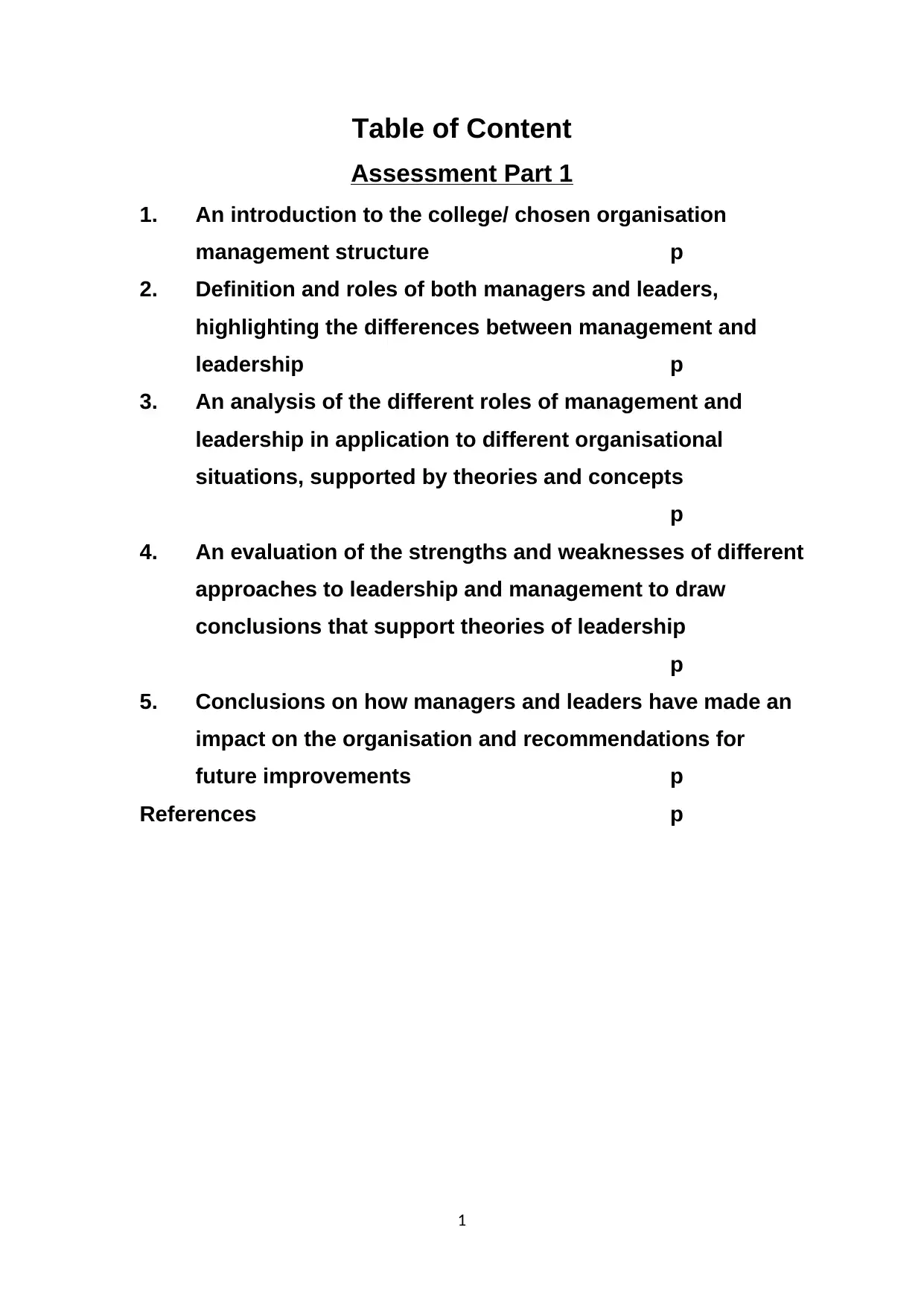
Table of Content
Assessment Part 1
1. An introduction to the college/ chosen organisation
management structure p
2. Definition and roles of both managers and leaders,
highlighting the differences between management and
leadership p
3. An analysis of the different roles of management and
leadership in application to different organisational
situations, supported by theories and concepts
p
4. An evaluation of the strengths and weaknesses of different
approaches to leadership and management to draw
conclusions that support theories of leadership
p
5. Conclusions on how managers and leaders have made an
impact on the organisation and recommendations for
future improvements p
References p
1
Assessment Part 1
1. An introduction to the college/ chosen organisation
management structure p
2. Definition and roles of both managers and leaders,
highlighting the differences between management and
leadership p
3. An analysis of the different roles of management and
leadership in application to different organisational
situations, supported by theories and concepts
p
4. An evaluation of the strengths and weaknesses of different
approaches to leadership and management to draw
conclusions that support theories of leadership
p
5. Conclusions on how managers and leaders have made an
impact on the organisation and recommendations for
future improvements p
References p
1
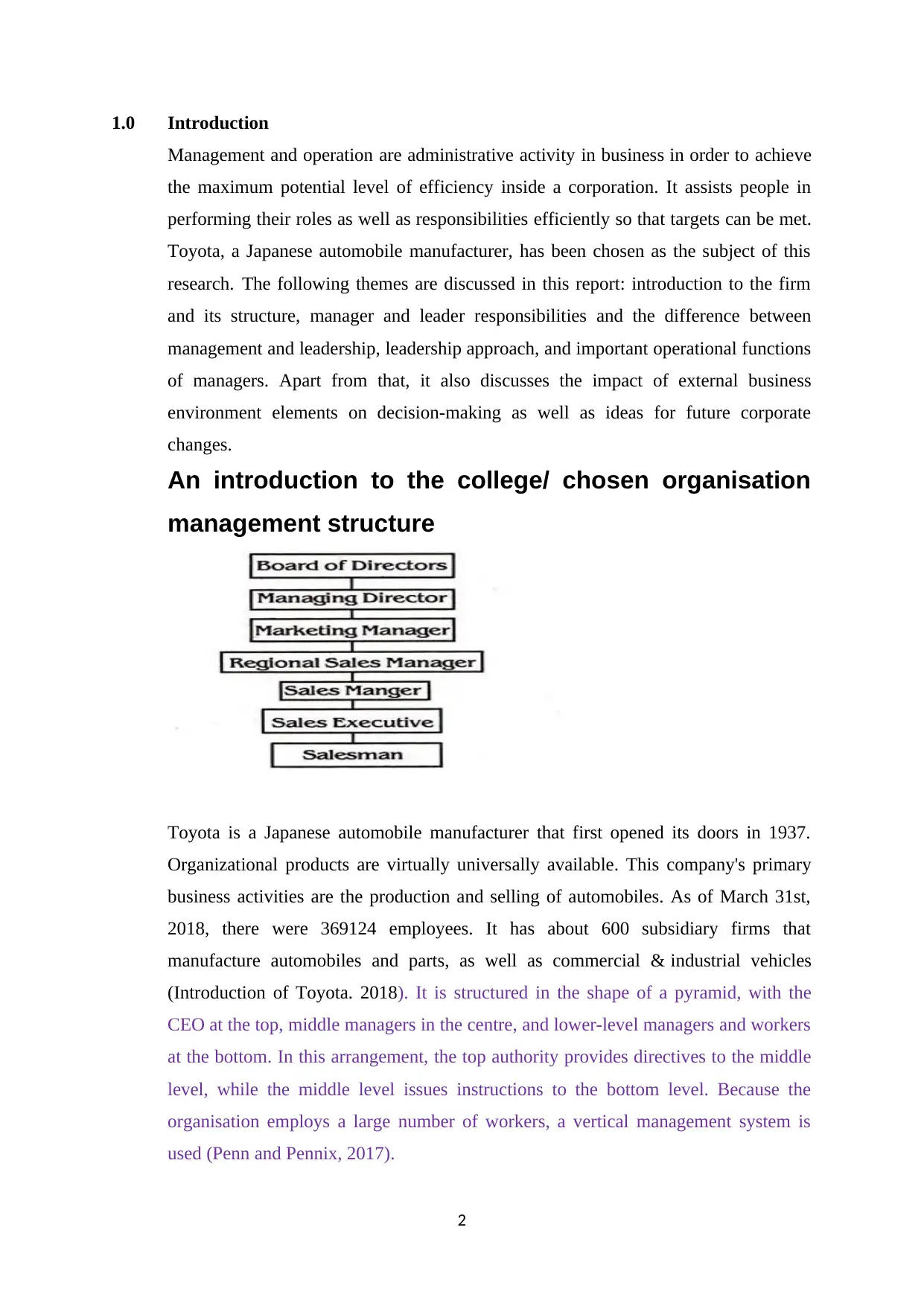
1.0 Introduction
Management and operation are administrative activity in business in order to achieve
the maximum potential level of efficiency inside a corporation. It assists people in
performing their roles as well as responsibilities efficiently so that targets can be met.
Toyota, a Japanese automobile manufacturer, has been chosen as the subject of this
research. The following themes are discussed in this report: introduction to the firm
and its structure, manager and leader responsibilities and the difference between
management and leadership, leadership approach, and important operational functions
of managers. Apart from that, it also discusses the impact of external business
environment elements on decision-making as well as ideas for future corporate
changes.
An introduction to the college/ chosen organisation
management structure
Toyota is a Japanese automobile manufacturer that first opened its doors in 1937.
Organizational products are virtually universally available. This company's primary
business activities are the production and selling of automobiles. As of March 31st,
2018, there were 369124 employees. It has about 600 subsidiary firms that
manufacture automobiles and parts, as well as commercial & industrial vehicles
(Introduction of Toyota. 2018). It is structured in the shape of a pyramid, with the
CEO at the top, middle managers in the centre, and lower-level managers and workers
at the bottom. In this arrangement, the top authority provides directives to the middle
level, while the middle level issues instructions to the bottom level. Because the
organisation employs a large number of workers, a vertical management system is
used (Penn and Pennix, 2017).
2
Management and operation are administrative activity in business in order to achieve
the maximum potential level of efficiency inside a corporation. It assists people in
performing their roles as well as responsibilities efficiently so that targets can be met.
Toyota, a Japanese automobile manufacturer, has been chosen as the subject of this
research. The following themes are discussed in this report: introduction to the firm
and its structure, manager and leader responsibilities and the difference between
management and leadership, leadership approach, and important operational functions
of managers. Apart from that, it also discusses the impact of external business
environment elements on decision-making as well as ideas for future corporate
changes.
An introduction to the college/ chosen organisation
management structure
Toyota is a Japanese automobile manufacturer that first opened its doors in 1937.
Organizational products are virtually universally available. This company's primary
business activities are the production and selling of automobiles. As of March 31st,
2018, there were 369124 employees. It has about 600 subsidiary firms that
manufacture automobiles and parts, as well as commercial & industrial vehicles
(Introduction of Toyota. 2018). It is structured in the shape of a pyramid, with the
CEO at the top, middle managers in the centre, and lower-level managers and workers
at the bottom. In this arrangement, the top authority provides directives to the middle
level, while the middle level issues instructions to the bottom level. Because the
organisation employs a large number of workers, a vertical management system is
used (Penn and Pennix, 2017).
2
⊘ This is a preview!⊘
Do you want full access?
Subscribe today to unlock all pages.

Trusted by 1+ million students worldwide
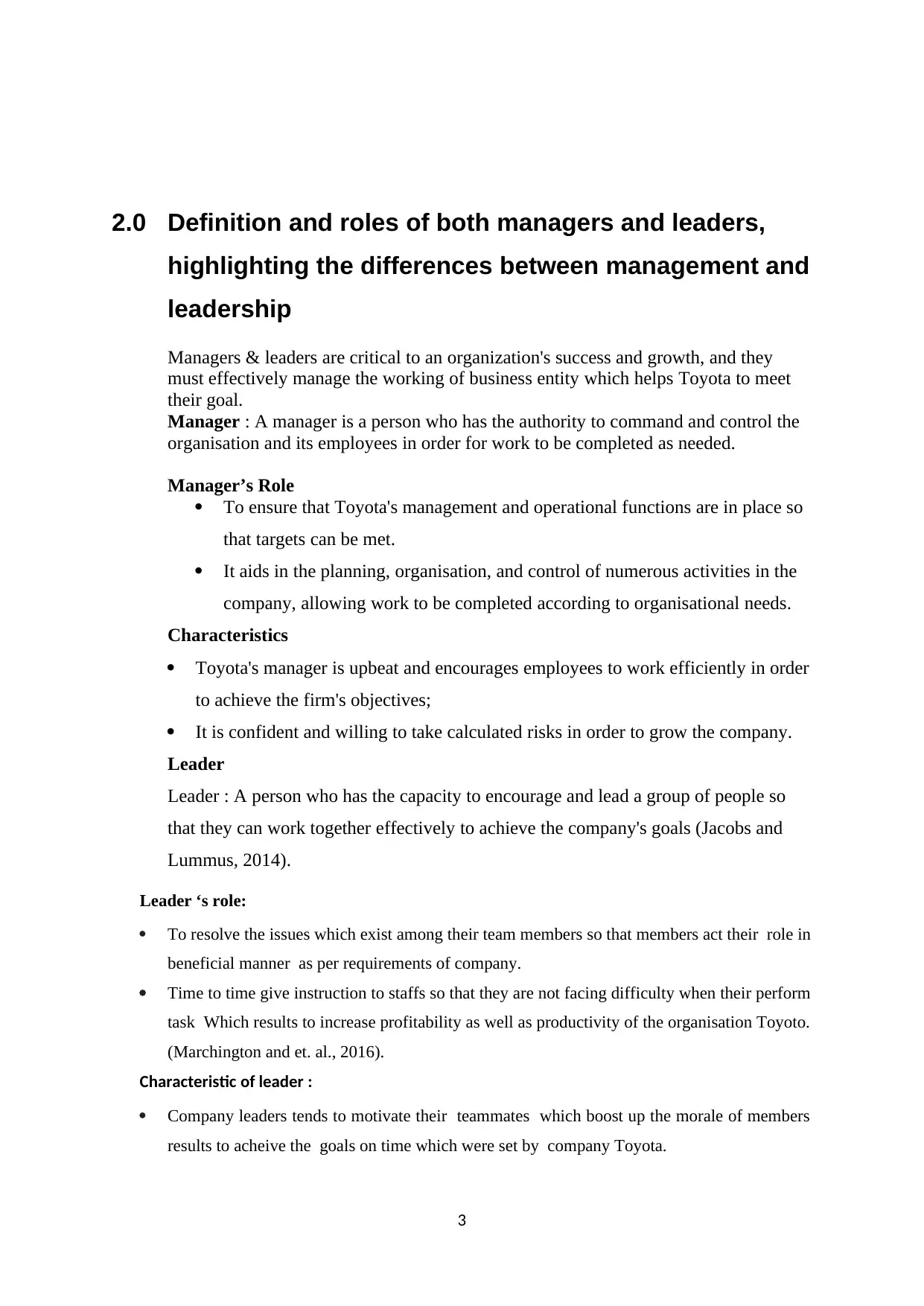
2.0 Definition and roles of both managers and leaders,
highlighting the differences between management and
leadership
Managers & leaders are critical to an organization's success and growth, and they
must effectively manage the working of business entity which helps Toyota to meet
their goal.
Manager : A manager is a person who has the authority to command and control the
organisation and its employees in order for work to be completed as needed.
Manager’s Role
To ensure that Toyota's management and operational functions are in place so
that targets can be met.
It aids in the planning, organisation, and control of numerous activities in the
company, allowing work to be completed according to organisational needs.
Characteristics
Toyota's manager is upbeat and encourages employees to work efficiently in order
to achieve the firm's objectives;
It is confident and willing to take calculated risks in order to grow the company.
Leader
Leader : A person who has the capacity to encourage and lead a group of people so
that they can work together effectively to achieve the company's goals (Jacobs and
Lummus, 2014).
Leader ‘s role:
To resolve the issues which exist among their team members so that members act their role in
beneficial manner as per requirements of company.
Time to time give instruction to staffs so that they are not facing difficulty when their perform
task Which results to increase profitability as well as productivity of the organisation Toyoto.
(Marchington and et. al., 2016).
Characteristic of leader :
Company leaders tends to motivate their teammates which boost up the morale of members
results to acheive the goals on time which were set by company Toyota.
3
highlighting the differences between management and
leadership
Managers & leaders are critical to an organization's success and growth, and they
must effectively manage the working of business entity which helps Toyota to meet
their goal.
Manager : A manager is a person who has the authority to command and control the
organisation and its employees in order for work to be completed as needed.
Manager’s Role
To ensure that Toyota's management and operational functions are in place so
that targets can be met.
It aids in the planning, organisation, and control of numerous activities in the
company, allowing work to be completed according to organisational needs.
Characteristics
Toyota's manager is upbeat and encourages employees to work efficiently in order
to achieve the firm's objectives;
It is confident and willing to take calculated risks in order to grow the company.
Leader
Leader : A person who has the capacity to encourage and lead a group of people so
that they can work together effectively to achieve the company's goals (Jacobs and
Lummus, 2014).
Leader ‘s role:
To resolve the issues which exist among their team members so that members act their role in
beneficial manner as per requirements of company.
Time to time give instruction to staffs so that they are not facing difficulty when their perform
task Which results to increase profitability as well as productivity of the organisation Toyoto.
(Marchington and et. al., 2016).
Characteristic of leader :
Company leaders tends to motivate their teammates which boost up the morale of members
results to acheive the goals on time which were set by company Toyota.
3
Paraphrase This Document
Need a fresh take? Get an instant paraphrase of this document with our AI Paraphraser
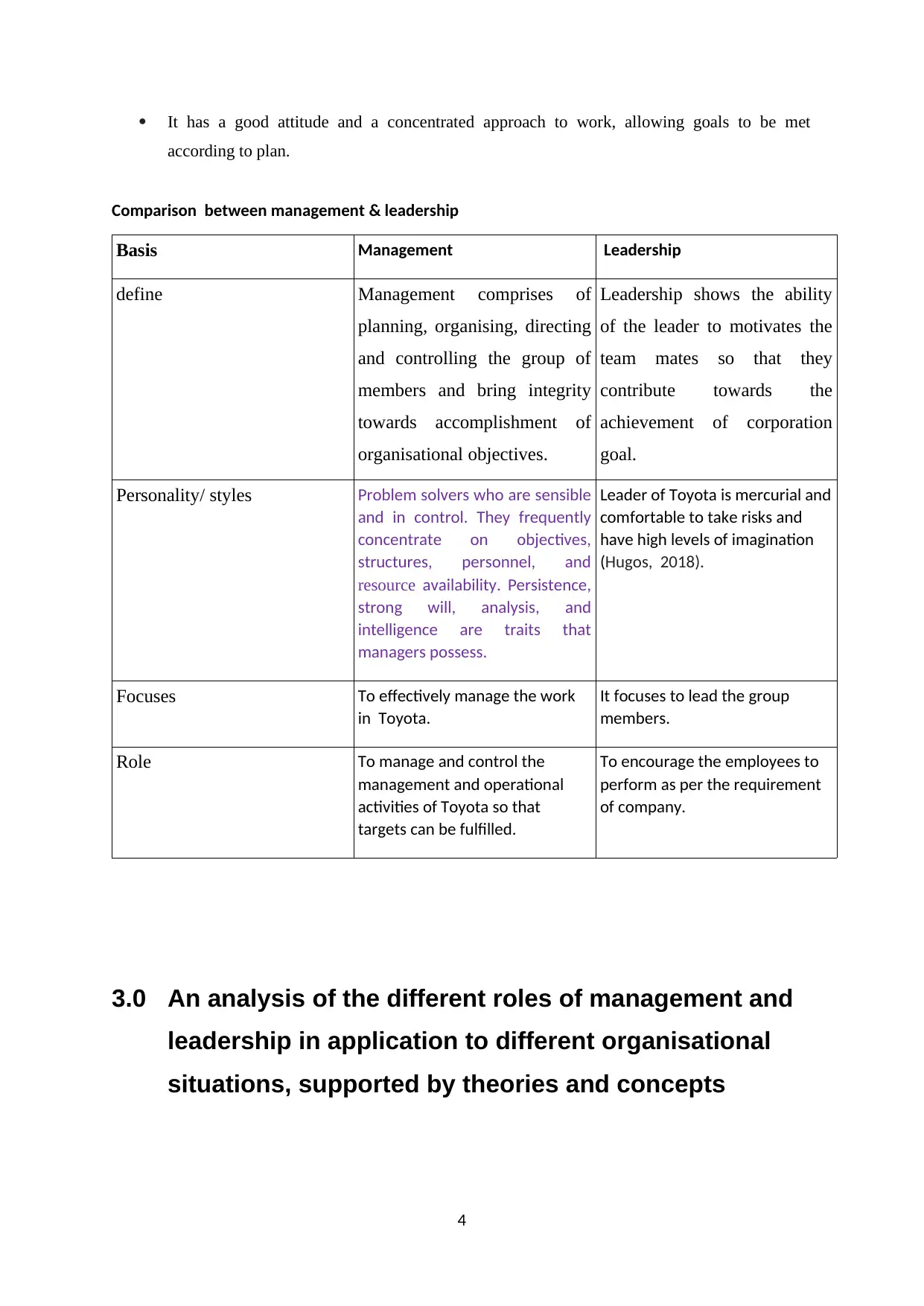
It has a good attitude and a concentrated approach to work, allowing goals to be met
according to plan.
Comparison between management & leadership
Basis Management Leadership
define Management comprises of
planning, organising, directing
and controlling the group of
members and bring integrity
towards accomplishment of
organisational objectives.
Leadership shows the ability
of the leader to motivates the
team mates so that they
contribute towards the
achievement of corporation
goal.
Personality/ styles Problem solvers who are sensible
and in control. They frequently
concentrate on objectives,
structures, personnel, and
resource availability. Persistence,
strong will, analysis, and
intelligence are traits that
managers possess.
Leader of Toyota is mercurial and
comfortable to take risks and
have high levels of imagination
(Hugos, 2018).
Focuses To effectively manage the work
in Toyota.
It focuses to lead the group
members.
Role To manage and control the
management and operational
activities of Toyota so that
targets can be fulfilled.
To encourage the employees to
perform as per the requirement
of company.
3.0 An analysis of the different roles of management and
leadership in application to different organisational
situations, supported by theories and concepts
4
according to plan.
Comparison between management & leadership
Basis Management Leadership
define Management comprises of
planning, organising, directing
and controlling the group of
members and bring integrity
towards accomplishment of
organisational objectives.
Leadership shows the ability
of the leader to motivates the
team mates so that they
contribute towards the
achievement of corporation
goal.
Personality/ styles Problem solvers who are sensible
and in control. They frequently
concentrate on objectives,
structures, personnel, and
resource availability. Persistence,
strong will, analysis, and
intelligence are traits that
managers possess.
Leader of Toyota is mercurial and
comfortable to take risks and
have high levels of imagination
(Hugos, 2018).
Focuses To effectively manage the work
in Toyota.
It focuses to lead the group
members.
Role To manage and control the
management and operational
activities of Toyota so that
targets can be fulfilled.
To encourage the employees to
perform as per the requirement
of company.
3.0 An analysis of the different roles of management and
leadership in application to different organisational
situations, supported by theories and concepts
4

Management as well as leadership are critical to an organization's success because they
oversee and supervise the company's operational activities, allowing targets to be met on
time. There are a number of theories that help Toyota to attain their targets
Situational theory suggests that leadership styles have changed as a result of
conditions that arise at work. As an example, suppose Toyota is required to produce
three hundred and fifty automobiles in twenty days in order to meet an urgent order.
In that instance, the manager decides that all employees must work an additional hour
in order to meet the goals. The function of leadership is to inspire employees to work
in accordance with the company's needs, allowing the company to realise its goals.
Contingency theory- Various activities are carried out on a regular basis in an
organisation. Toyota, for example, had a shortage of raw materials as a result of a
transportation strike. In that instance, the management decides to purchase raw
materials from local vendors in order to expedite the completion of an urgent order. In
that instance, the leader acts as a guide, employing proper leadership to motivate
people to complete work according to the corporation's wishes so that an urgent order
tends to be fulfilled (He and Chai, 2014).
System theory- It is critical for a corporation to follow a system so that duties may be
completed when needed. It helps a corporation's management to establish the
conditions and develop an organisational strategy in which people at all levels may
perform to their full potential. For example, Toyota's manager has established a
quality standard for automobile manufacturing in order to manufacture high-quality
products. In that instance, the responsibility of the leader is to give orders to all group
members to preserve the company's quality standards. As a result, production can
proceed according to the system's specifications.
4.0 An evaluation of the strengths and weaknesses of
different approaches to leadership and management
to draw conclusions that support theories of
leadership
5
oversee and supervise the company's operational activities, allowing targets to be met on
time. There are a number of theories that help Toyota to attain their targets
Situational theory suggests that leadership styles have changed as a result of
conditions that arise at work. As an example, suppose Toyota is required to produce
three hundred and fifty automobiles in twenty days in order to meet an urgent order.
In that instance, the manager decides that all employees must work an additional hour
in order to meet the goals. The function of leadership is to inspire employees to work
in accordance with the company's needs, allowing the company to realise its goals.
Contingency theory- Various activities are carried out on a regular basis in an
organisation. Toyota, for example, had a shortage of raw materials as a result of a
transportation strike. In that instance, the management decides to purchase raw
materials from local vendors in order to expedite the completion of an urgent order. In
that instance, the leader acts as a guide, employing proper leadership to motivate
people to complete work according to the corporation's wishes so that an urgent order
tends to be fulfilled (He and Chai, 2014).
System theory- It is critical for a corporation to follow a system so that duties may be
completed when needed. It helps a corporation's management to establish the
conditions and develop an organisational strategy in which people at all levels may
perform to their full potential. For example, Toyota's manager has established a
quality standard for automobile manufacturing in order to manufacture high-quality
products. In that instance, the responsibility of the leader is to give orders to all group
members to preserve the company's quality standards. As a result, production can
proceed according to the system's specifications.
4.0 An evaluation of the strengths and weaknesses of
different approaches to leadership and management
to draw conclusions that support theories of
leadership
5
⊘ This is a preview!⊘
Do you want full access?
Subscribe today to unlock all pages.

Trusted by 1+ million students worldwide
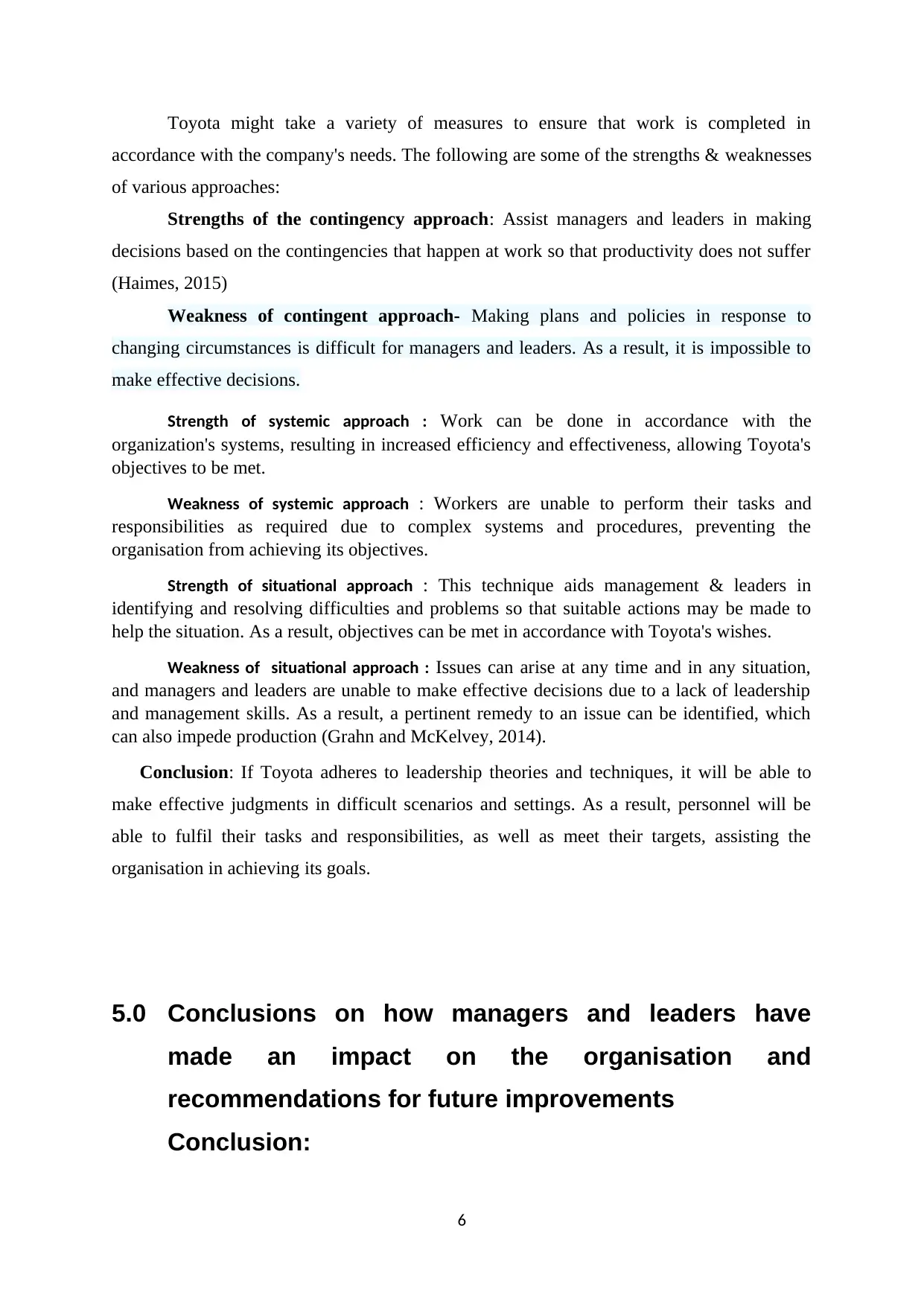
Toyota might take a variety of measures to ensure that work is completed in
accordance with the company's needs. The following are some of the strengths & weaknesses
of various approaches:
Strengths of the contingency approach: Assist managers and leaders in making
decisions based on the contingencies that happen at work so that productivity does not suffer
(Haimes, 2015)
Weakness of contingent approach- Making plans and policies in response to
changing circumstances is difficult for managers and leaders. As a result, it is impossible to
make effective decisions.
Strength of systemic approach : Work can be done in accordance with the
organization's systems, resulting in increased efficiency and effectiveness, allowing Toyota's
objectives to be met.
Weakness of systemic approach : Workers are unable to perform their tasks and
responsibilities as required due to complex systems and procedures, preventing the
organisation from achieving its objectives.
Strength of situational approach : This technique aids management & leaders in
identifying and resolving difficulties and problems so that suitable actions may be made to
help the situation. As a result, objectives can be met in accordance with Toyota's wishes.
Weakness of situational approach : Issues can arise at any time and in any situation,
and managers and leaders are unable to make effective decisions due to a lack of leadership
and management skills. As a result, a pertinent remedy to an issue can be identified, which
can also impede production (Grahn and McKelvey, 2014).
Conclusion: If Toyota adheres to leadership theories and techniques, it will be able to
make effective judgments in difficult scenarios and settings. As a result, personnel will be
able to fulfil their tasks and responsibilities, as well as meet their targets, assisting the
organisation in achieving its goals.
5.0 Conclusions on how managers and leaders have
made an impact on the organisation and
recommendations for future improvements
Conclusion:
6
accordance with the company's needs. The following are some of the strengths & weaknesses
of various approaches:
Strengths of the contingency approach: Assist managers and leaders in making
decisions based on the contingencies that happen at work so that productivity does not suffer
(Haimes, 2015)
Weakness of contingent approach- Making plans and policies in response to
changing circumstances is difficult for managers and leaders. As a result, it is impossible to
make effective decisions.
Strength of systemic approach : Work can be done in accordance with the
organization's systems, resulting in increased efficiency and effectiveness, allowing Toyota's
objectives to be met.
Weakness of systemic approach : Workers are unable to perform their tasks and
responsibilities as required due to complex systems and procedures, preventing the
organisation from achieving its objectives.
Strength of situational approach : This technique aids management & leaders in
identifying and resolving difficulties and problems so that suitable actions may be made to
help the situation. As a result, objectives can be met in accordance with Toyota's wishes.
Weakness of situational approach : Issues can arise at any time and in any situation,
and managers and leaders are unable to make effective decisions due to a lack of leadership
and management skills. As a result, a pertinent remedy to an issue can be identified, which
can also impede production (Grahn and McKelvey, 2014).
Conclusion: If Toyota adheres to leadership theories and techniques, it will be able to
make effective judgments in difficult scenarios and settings. As a result, personnel will be
able to fulfil their tasks and responsibilities, as well as meet their targets, assisting the
organisation in achieving its goals.
5.0 Conclusions on how managers and leaders have
made an impact on the organisation and
recommendations for future improvements
Conclusion:
6
Paraphrase This Document
Need a fresh take? Get an instant paraphrase of this document with our AI Paraphraser
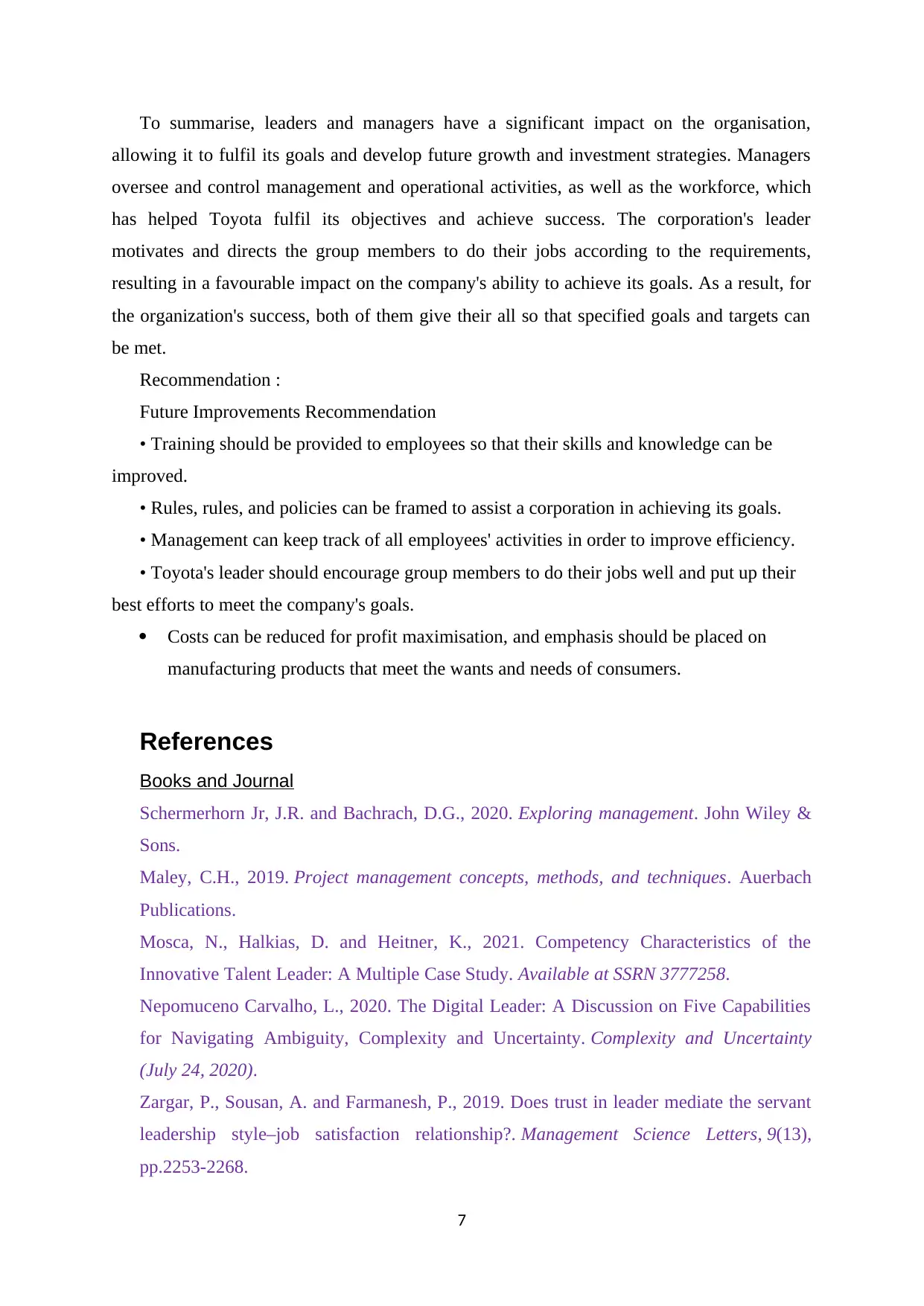
To summarise, leaders and managers have a significant impact on the organisation,
allowing it to fulfil its goals and develop future growth and investment strategies. Managers
oversee and control management and operational activities, as well as the workforce, which
has helped Toyota fulfil its objectives and achieve success. The corporation's leader
motivates and directs the group members to do their jobs according to the requirements,
resulting in a favourable impact on the company's ability to achieve its goals. As a result, for
the organization's success, both of them give their all so that specified goals and targets can
be met.
Recommendation :
Future Improvements Recommendation
• Training should be provided to employees so that their skills and knowledge can be
improved.
• Rules, rules, and policies can be framed to assist a corporation in achieving its goals.
• Management can keep track of all employees' activities in order to improve efficiency.
• Toyota's leader should encourage group members to do their jobs well and put up their
best efforts to meet the company's goals.
Costs can be reduced for profit maximisation, and emphasis should be placed on
manufacturing products that meet the wants and needs of consumers.
References
Books and Journal
Schermerhorn Jr, J.R. and Bachrach, D.G., 2020. Exploring management. John Wiley &
Sons.
Maley, C.H., 2019. Project management concepts, methods, and techniques. Auerbach
Publications.
Mosca, N., Halkias, D. and Heitner, K., 2021. Competency Characteristics of the
Innovative Talent Leader: A Multiple Case Study. Available at SSRN 3777258.
Nepomuceno Carvalho, L., 2020. The Digital Leader: A Discussion on Five Capabilities
for Navigating Ambiguity, Complexity and Uncertainty. Complexity and Uncertainty
(July 24, 2020).
Zargar, P., Sousan, A. and Farmanesh, P., 2019. Does trust in leader mediate the servant
leadership style–job satisfaction relationship?. Management Science Letters, 9(13),
pp.2253-2268.
7
allowing it to fulfil its goals and develop future growth and investment strategies. Managers
oversee and control management and operational activities, as well as the workforce, which
has helped Toyota fulfil its objectives and achieve success. The corporation's leader
motivates and directs the group members to do their jobs according to the requirements,
resulting in a favourable impact on the company's ability to achieve its goals. As a result, for
the organization's success, both of them give their all so that specified goals and targets can
be met.
Recommendation :
Future Improvements Recommendation
• Training should be provided to employees so that their skills and knowledge can be
improved.
• Rules, rules, and policies can be framed to assist a corporation in achieving its goals.
• Management can keep track of all employees' activities in order to improve efficiency.
• Toyota's leader should encourage group members to do their jobs well and put up their
best efforts to meet the company's goals.
Costs can be reduced for profit maximisation, and emphasis should be placed on
manufacturing products that meet the wants and needs of consumers.
References
Books and Journal
Schermerhorn Jr, J.R. and Bachrach, D.G., 2020. Exploring management. John Wiley &
Sons.
Maley, C.H., 2019. Project management concepts, methods, and techniques. Auerbach
Publications.
Mosca, N., Halkias, D. and Heitner, K., 2021. Competency Characteristics of the
Innovative Talent Leader: A Multiple Case Study. Available at SSRN 3777258.
Nepomuceno Carvalho, L., 2020. The Digital Leader: A Discussion on Five Capabilities
for Navigating Ambiguity, Complexity and Uncertainty. Complexity and Uncertainty
(July 24, 2020).
Zargar, P., Sousan, A. and Farmanesh, P., 2019. Does trust in leader mediate the servant
leadership style–job satisfaction relationship?. Management Science Letters, 9(13),
pp.2253-2268.
7
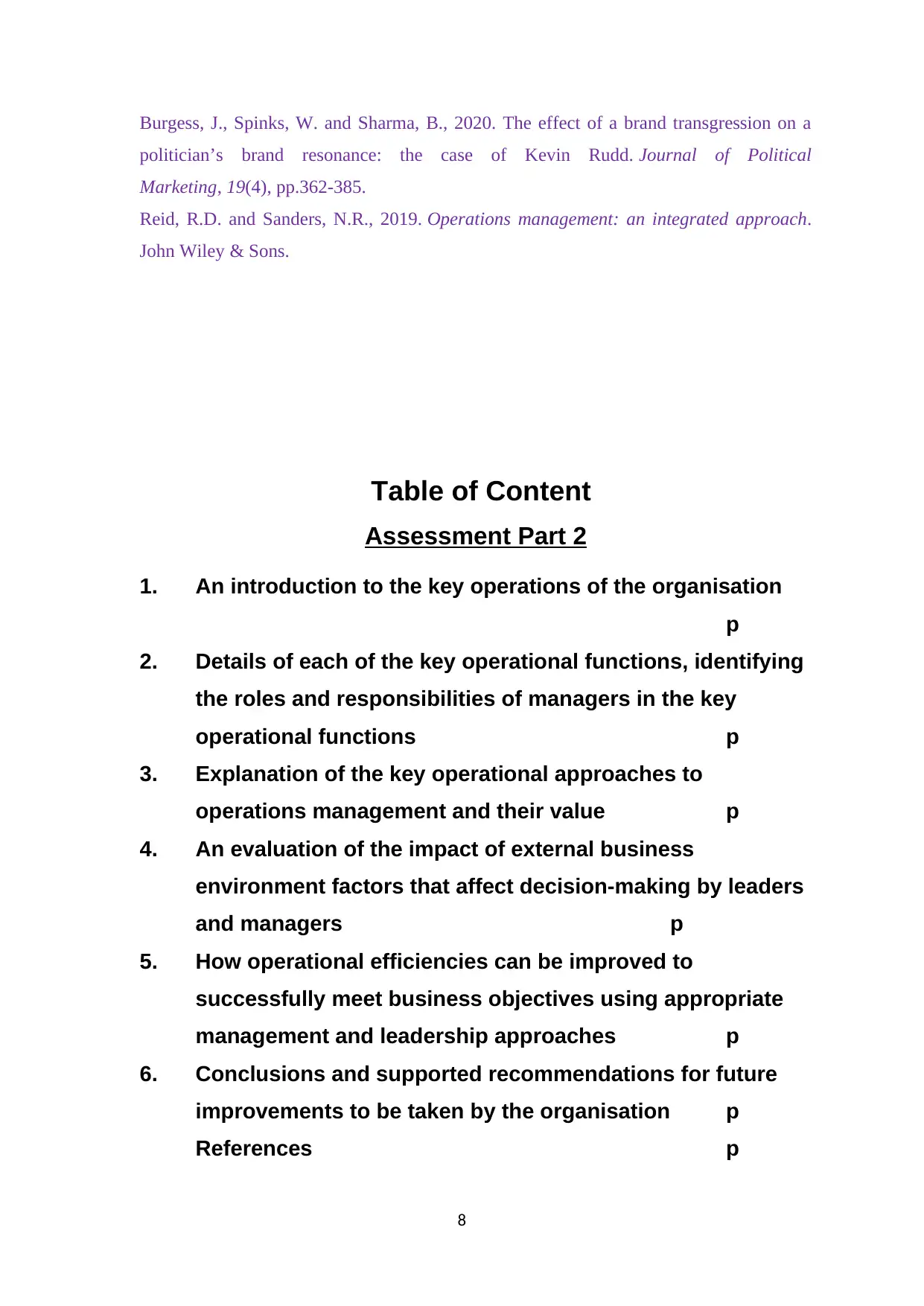
Burgess, J., Spinks, W. and Sharma, B., 2020. The effect of a brand transgression on a
politician’s brand resonance: the case of Kevin Rudd. Journal of Political
Marketing, 19(4), pp.362-385.
Reid, R.D. and Sanders, N.R., 2019. Operations management: an integrated approach.
John Wiley & Sons.
Table of Content
Assessment Part 2
1. An introduction to the key operations of the organisation
p
2. Details of each of the key operational functions, identifying
the roles and responsibilities of managers in the key
operational functions p
3. Explanation of the key operational approaches to
operations management and their value p
4. An evaluation of the impact of external business
environment factors that affect decision-making by leaders
and managers p
5. How operational efficiencies can be improved to
successfully meet business objectives using appropriate
management and leadership approaches p
6. Conclusions and supported recommendations for future
improvements to be taken by the organisation p
References p
8
politician’s brand resonance: the case of Kevin Rudd. Journal of Political
Marketing, 19(4), pp.362-385.
Reid, R.D. and Sanders, N.R., 2019. Operations management: an integrated approach.
John Wiley & Sons.
Table of Content
Assessment Part 2
1. An introduction to the key operations of the organisation
p
2. Details of each of the key operational functions, identifying
the roles and responsibilities of managers in the key
operational functions p
3. Explanation of the key operational approaches to
operations management and their value p
4. An evaluation of the impact of external business
environment factors that affect decision-making by leaders
and managers p
5. How operational efficiencies can be improved to
successfully meet business objectives using appropriate
management and leadership approaches p
6. Conclusions and supported recommendations for future
improvements to be taken by the organisation p
References p
8
⊘ This is a preview!⊘
Do you want full access?
Subscribe today to unlock all pages.

Trusted by 1+ million students worldwide
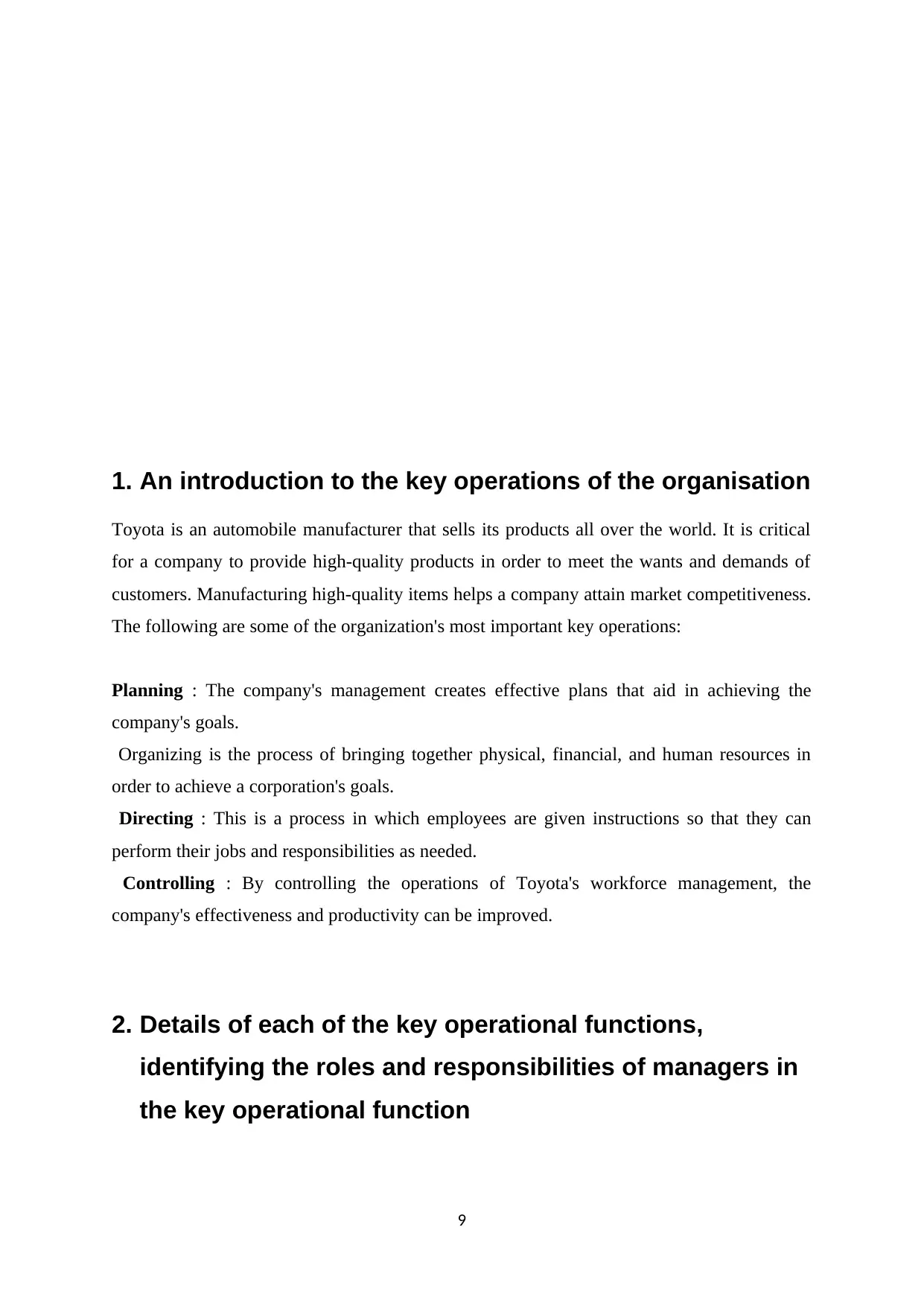
1. An introduction to the key operations of the organisation
Toyota is an automobile manufacturer that sells its products all over the world. It is critical
for a company to provide high-quality products in order to meet the wants and demands of
customers. Manufacturing high-quality items helps a company attain market competitiveness.
The following are some of the organization's most important key operations:
Planning : The company's management creates effective plans that aid in achieving the
company's goals.
Organizing is the process of bringing together physical, financial, and human resources in
order to achieve a corporation's goals.
Directing : This is a process in which employees are given instructions so that they can
perform their jobs and responsibilities as needed.
Controlling : By controlling the operations of Toyota's workforce management, the
company's effectiveness and productivity can be improved.
2. Details of each of the key operational functions,
identifying the roles and responsibilities of managers in
the key operational function
9
Toyota is an automobile manufacturer that sells its products all over the world. It is critical
for a company to provide high-quality products in order to meet the wants and demands of
customers. Manufacturing high-quality items helps a company attain market competitiveness.
The following are some of the organization's most important key operations:
Planning : The company's management creates effective plans that aid in achieving the
company's goals.
Organizing is the process of bringing together physical, financial, and human resources in
order to achieve a corporation's goals.
Directing : This is a process in which employees are given instructions so that they can
perform their jobs and responsibilities as needed.
Controlling : By controlling the operations of Toyota's workforce management, the
company's effectiveness and productivity can be improved.
2. Details of each of the key operational functions,
identifying the roles and responsibilities of managers in
the key operational function
9
Paraphrase This Document
Need a fresh take? Get an instant paraphrase of this document with our AI Paraphraser
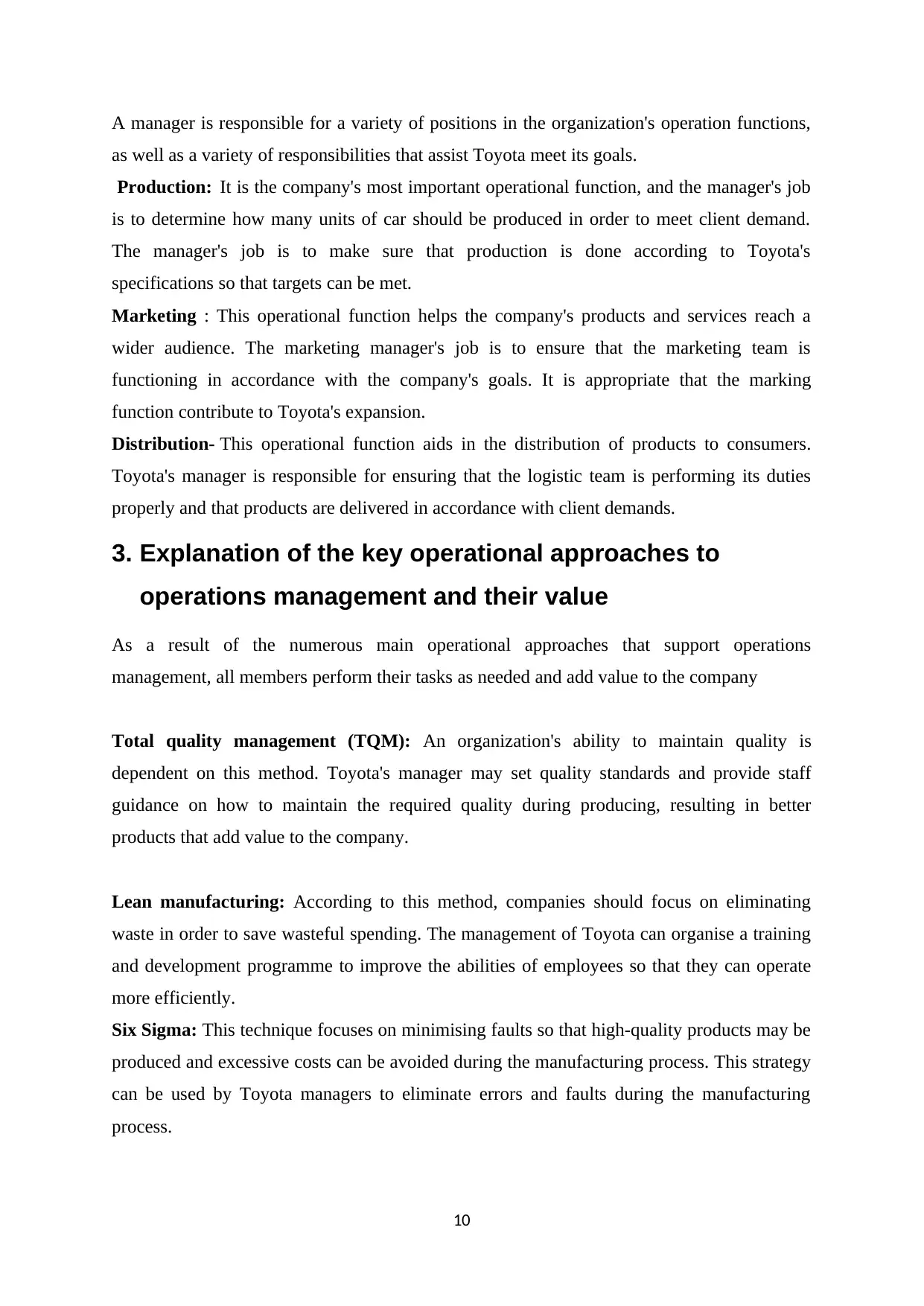
A manager is responsible for a variety of positions in the organization's operation functions,
as well as a variety of responsibilities that assist Toyota meet its goals.
Production: It is the company's most important operational function, and the manager's job
is to determine how many units of car should be produced in order to meet client demand.
The manager's job is to make sure that production is done according to Toyota's
specifications so that targets can be met.
Marketing : This operational function helps the company's products and services reach a
wider audience. The marketing manager's job is to ensure that the marketing team is
functioning in accordance with the company's goals. It is appropriate that the marking
function contribute to Toyota's expansion.
Distribution- This operational function aids in the distribution of products to consumers.
Toyota's manager is responsible for ensuring that the logistic team is performing its duties
properly and that products are delivered in accordance with client demands.
3. Explanation of the key operational approaches to
operations management and their value
As a result of the numerous main operational approaches that support operations
management, all members perform their tasks as needed and add value to the company
Total quality management (TQM): An organization's ability to maintain quality is
dependent on this method. Toyota's manager may set quality standards and provide staff
guidance on how to maintain the required quality during producing, resulting in better
products that add value to the company.
Lean manufacturing: According to this method, companies should focus on eliminating
waste in order to save wasteful spending. The management of Toyota can organise a training
and development programme to improve the abilities of employees so that they can operate
more efficiently.
Six Sigma: This technique focuses on minimising faults so that high-quality products may be
produced and excessive costs can be avoided during the manufacturing process. This strategy
can be used by Toyota managers to eliminate errors and faults during the manufacturing
process.
10
as well as a variety of responsibilities that assist Toyota meet its goals.
Production: It is the company's most important operational function, and the manager's job
is to determine how many units of car should be produced in order to meet client demand.
The manager's job is to make sure that production is done according to Toyota's
specifications so that targets can be met.
Marketing : This operational function helps the company's products and services reach a
wider audience. The marketing manager's job is to ensure that the marketing team is
functioning in accordance with the company's goals. It is appropriate that the marking
function contribute to Toyota's expansion.
Distribution- This operational function aids in the distribution of products to consumers.
Toyota's manager is responsible for ensuring that the logistic team is performing its duties
properly and that products are delivered in accordance with client demands.
3. Explanation of the key operational approaches to
operations management and their value
As a result of the numerous main operational approaches that support operations
management, all members perform their tasks as needed and add value to the company
Total quality management (TQM): An organization's ability to maintain quality is
dependent on this method. Toyota's manager may set quality standards and provide staff
guidance on how to maintain the required quality during producing, resulting in better
products that add value to the company.
Lean manufacturing: According to this method, companies should focus on eliminating
waste in order to save wasteful spending. The management of Toyota can organise a training
and development programme to improve the abilities of employees so that they can operate
more efficiently.
Six Sigma: This technique focuses on minimising faults so that high-quality products may be
produced and excessive costs can be avoided during the manufacturing process. This strategy
can be used by Toyota managers to eliminate errors and faults during the manufacturing
process.
10
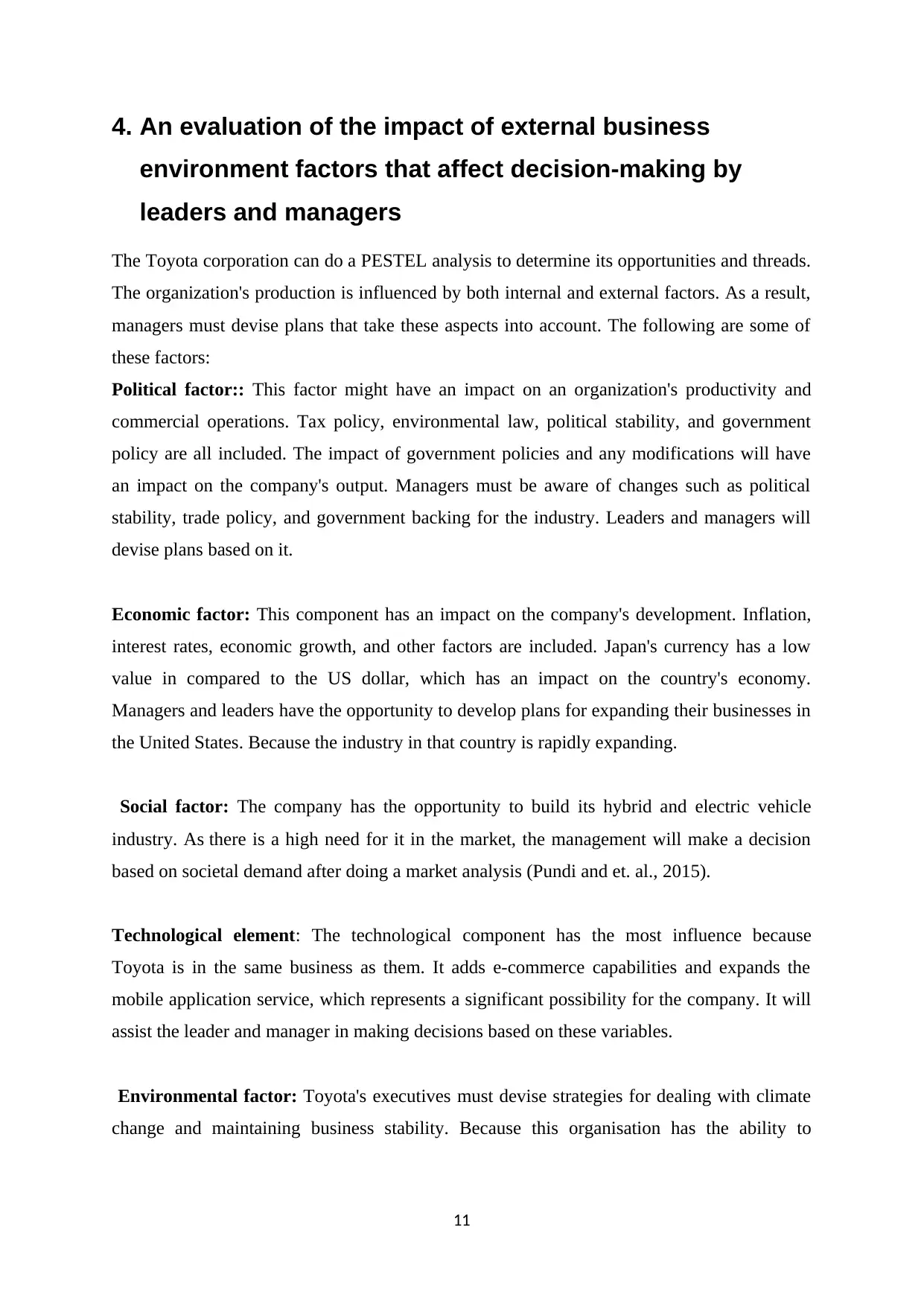
4. An evaluation of the impact of external business
environment factors that affect decision-making by
leaders and managers
The Toyota corporation can do a PESTEL analysis to determine its opportunities and threads.
The organization's production is influenced by both internal and external factors. As a result,
managers must devise plans that take these aspects into account. The following are some of
these factors:
Political factor:: This factor might have an impact on an organization's productivity and
commercial operations. Tax policy, environmental law, political stability, and government
policy are all included. The impact of government policies and any modifications will have
an impact on the company's output. Managers must be aware of changes such as political
stability, trade policy, and government backing for the industry. Leaders and managers will
devise plans based on it.
Economic factor: This component has an impact on the company's development. Inflation,
interest rates, economic growth, and other factors are included. Japan's currency has a low
value in compared to the US dollar, which has an impact on the country's economy.
Managers and leaders have the opportunity to develop plans for expanding their businesses in
the United States. Because the industry in that country is rapidly expanding.
Social factor: The company has the opportunity to build its hybrid and electric vehicle
industry. As there is a high need for it in the market, the management will make a decision
based on societal demand after doing a market analysis (Pundi and et. al., 2015).
Technological element: The technological component has the most influence because
Toyota is in the same business as them. It adds e-commerce capabilities and expands the
mobile application service, which represents a significant possibility for the company. It will
assist the leader and manager in making decisions based on these variables.
Environmental factor: Toyota's executives must devise strategies for dealing with climate
change and maintaining business stability. Because this organisation has the ability to
11
environment factors that affect decision-making by
leaders and managers
The Toyota corporation can do a PESTEL analysis to determine its opportunities and threads.
The organization's production is influenced by both internal and external factors. As a result,
managers must devise plans that take these aspects into account. The following are some of
these factors:
Political factor:: This factor might have an impact on an organization's productivity and
commercial operations. Tax policy, environmental law, political stability, and government
policy are all included. The impact of government policies and any modifications will have
an impact on the company's output. Managers must be aware of changes such as political
stability, trade policy, and government backing for the industry. Leaders and managers will
devise plans based on it.
Economic factor: This component has an impact on the company's development. Inflation,
interest rates, economic growth, and other factors are included. Japan's currency has a low
value in compared to the US dollar, which has an impact on the country's economy.
Managers and leaders have the opportunity to develop plans for expanding their businesses in
the United States. Because the industry in that country is rapidly expanding.
Social factor: The company has the opportunity to build its hybrid and electric vehicle
industry. As there is a high need for it in the market, the management will make a decision
based on societal demand after doing a market analysis (Pundi and et. al., 2015).
Technological element: The technological component has the most influence because
Toyota is in the same business as them. It adds e-commerce capabilities and expands the
mobile application service, which represents a significant possibility for the company. It will
assist the leader and manager in making decisions based on these variables.
Environmental factor: Toyota's executives must devise strategies for dealing with climate
change and maintaining business stability. Because this organisation has the ability to
11
⊘ This is a preview!⊘
Do you want full access?
Subscribe today to unlock all pages.

Trusted by 1+ million students worldwide
1 out of 15
Related Documents
Your All-in-One AI-Powered Toolkit for Academic Success.
+13062052269
info@desklib.com
Available 24*7 on WhatsApp / Email
![[object Object]](/_next/static/media/star-bottom.7253800d.svg)
Unlock your academic potential
Copyright © 2020–2025 A2Z Services. All Rights Reserved. Developed and managed by ZUCOL.





